There are different types of mulch and you should consider which mulch type is best for you, depending on a number of factors. Follow this guide to learn what different mulches are made of and what the advantages and disadvantages are of each type.

What Is Mulch
Mulch is a layer of material that gets spread over the surface of the soil. That’s the generic definition you’ll find when clicking through the internet. Personally, I’m not a fan of the vagueness in this definition. In this definition mulch can be pretty much anything, from organic products like bark, wood, and pine needles to inorganic products like rubber, plastic, and stone. I could never advise you to walk into your local garden center, point to a pile of stone, and say “I’ll take that mulch right over there.” You would definitely get some confused looks.
Instead, let’s break things down into 3 types of mulch: Bark Mulch, Wood Chips, and Pine Straw Mulch. Usually when professionals talk about mulch, they are referring to one of these 3 mulch types.
What makes mulch a surprisingly confusing topic is it varies so much by region, and even by local supplier. Here in the Northeast, I get beautiful shredded, aged, bark mulch. But not too far from my local supplier is a garden center that sells the same product only it’s mixed with 50% wood chips. Believe it or not there’s actually a big difference in products (more on that below).
In the south, you might see more pine straw mulch than bark mulch in some areas. The truth is, there’s a time and place for all these mulches. Let’s take a look at these different types of mulch so you can better understand what they are made of and when to use them.
1. Bark Mulch
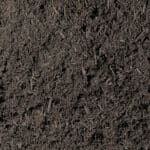
Among all the mulch types, most professionals would put Bark Mulch at the top of the list. Bark mulch is, as the name suggests, made from the bark of a tree. True bark mulch does not contain any actual wood from the inside of the tree, just the bark. It’s important to note the differences between the bark and the actual wood inside the tree. When installing mulch in a landscape bed with plants, especially delicate plants, bark mulch is what you want. Bark is more nutrient dense and its organic matter enriches the soil.
Before investing in bark mulch, you need to do some investigating. Not all bark mulch is created equal, and it’s important you consider the following:
Purity
Don’t be afraid to ask your local supplier if their bark mulch is 100% bark. A lot of advertised bark mulch products contain wood from inside the tree, or other wood products that are not bark. It’s actually common to see shredded wooden pallets in some bark mulch mixes. I’m not saying this is a deal breaker if your bark mulch does contain some of these fillers, I just want you to be aware of what you’re getting. If there’s another product that’s 100% pure across town for a small markup in price, you might want to go with the better product.
Shredded and Aged
Shredded and Aged are two words you want to see when purchasing bark mulch. You’ll get better weed suppression, and moisture retention from shredded mulch vs large chunks of mulch. Also, most people would agree that shredded mulch looks nice, although that is of course an opinion.
Also, aged mulch is superior to fresh mulch. When mulch is aged, the nutrients are more available when introduced to the soil. This will be beneficial to plants, especially those close to the surface. When bark mulch is fresh it’s more likely to be toxic to plants as it can emit toxic compounds during the early stages of the decomposition process. Aged bark mulch is past this initial decomposition phase.
Hardwood vs. Softwood
This is more of a regional thing but you may see hardwood bark mulch blends that come from trees such as maple and oaks. You may also see softwood blends that come from pine, hemlock, cedar, or other softwoods. Some people argue that softwood bark mulch is better for acid loving plants which most softwoods are, and hardwood bark mulch should be used for plants that prefer a more basic soil pH. The truth is, by the time either of these products get decomposed into the soil they won’t have a large effect on the pH. The biggest effect will be early on and to the very surface of the soil. So overall it’s something you can consider if you’re planting around smaller plants closer to the surface but it shouldn’t matter too much overall. Personally, I’d go buy whatever mix looks better. I’m from New Hampshire where we have beautiful softwood mixes with a rich natural color. That’s usually the mulch I choose.
Dyed or Natural Color
Dyed mulches tend to get a bad rap. People think the dye is toxic and can be damaging to plants. There’s actually been studies on this and there is no evidence that shows dyes in mulch negatively effect plants or soil health. Dyes are usually carbon based or iron oxide based and while iron and carbon might be delivered to the soil in small amounts, it is not harmful to plant life.
Dyed mulch will hold its color longer than most natural blends which is a huge advantage. Also, if you’re going for that rich dark black look that has a strong visual impact on our landscape, chances are there is dye in it.
When choosing dyed mulch products just be extra cautious to the purity of the product. Chances are you’ll see some non bark wood products in dyed mixes because they hold the color of the dye better. Again, it’s not a bad thing if it’s not pure bark mulch, just make sure you’re not getting a mulch that is predominantly shredded wood that has been dyed.
Bark Mulch Pros and Cons
Pros:
- Excellent weed suppression
- Excellent moisture retention
- Best visual impact
- Nutrient rich and beneficial to plants and soil health
Cons:
- Usually the most expensive choice
- May not be available in your region
- You need to ask about the purity so you know what you’re getting
2. Wood Chips
 Unlike bark mulch, wood chips contain mostly the wood from trees, not the bark. Wood chips at your local garden center will come from local tree companies that have run trees or limbs through a chipper and into their truck, and then dumped at the site of the sales location. It’s a direct process that isn’t as involved as manufacturing bark mulch.
Unlike bark mulch, wood chips contain mostly the wood from trees, not the bark. Wood chips at your local garden center will come from local tree companies that have run trees or limbs through a chipper and into their truck, and then dumped at the site of the sales location. It’s a direct process that isn’t as involved as manufacturing bark mulch.
When price shopping at your local garden center, you may be tempted to choose the lower priced woods chips for mulching your landscape beds, but I would advise you to be careful. Fresh wood chips can give off toxic compounds as they begin to decompose. These compounds can harm plants that are more delicate, with root systems closer to the soil surface. They also lack the upfront nutrient richness and soil amendment properties that bark mulch has, although as the wood chips break down they will provide some nutrients over time.
Another talked about negative with fresh wood chips is nitrogen depletion. This means that the fresh wood chips can suck up the nitrogen of the soil along the surface when first installed. While this is true, this really only occurs along the surface. This means your trees and shrubs shouldn’t be affected, but smaller plants with a shallow root system along the surface can be robbed of their nearby nitrogen.
Overall, there’s a time and a place for wood chips. If you have woodland plantings, or landscape beds that are primarily trees and shrubs then you should be safe using fresh wood chips. I would think twice about planting around annuals and perennials, especially if they are less established plants.
Wood Chips Pros and Cons
Pros:
- Cheaper alternative
- Excellent weed suppression
- Good water retention
Cons:
- Can be harmful to smaller plants along the surface
- Not as visually appealing (opinion)
3. Pine Straw Mulch
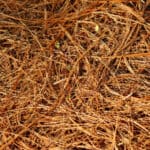 In some areas, mostly in the South, Pine Straw Mulch is common. Pine Straw Mulch is made from fallen pine needles. It is cheap, lightweight, easy to come by, and has a lot of the same benefits that bark/wood mulches have. A northerner might see it as odd to use pine needles as mulch, but unlike northern pines, the Southern Long Leaf Pine has a thicker, coarser needle, that lasts long when used in mulch beds. There is also a Southern Short Needle Pine, which has smaller needles, and also Slash Pine Straw which has slightly longer and thicker needles than the Short Needle Pine, but the preferred choice is usually the Southern Long Leaf Pine.
In some areas, mostly in the South, Pine Straw Mulch is common. Pine Straw Mulch is made from fallen pine needles. It is cheap, lightweight, easy to come by, and has a lot of the same benefits that bark/wood mulches have. A northerner might see it as odd to use pine needles as mulch, but unlike northern pines, the Southern Long Leaf Pine has a thicker, coarser needle, that lasts long when used in mulch beds. There is also a Southern Short Needle Pine, which has smaller needles, and also Slash Pine Straw which has slightly longer and thicker needles than the Short Needle Pine, but the preferred choice is usually the Southern Long Leaf Pine.
Some people are skeptical of pine needles because they believe it can throw the pH balance off. Pine needles are acidic and therefor they have a reputation of lowering pH levels in the soil. There’s actually been studies on this that have proven this is not true. While pine needles are acidic, by the time they break down into the soil they become neutralized and have little to no effect on soil pH.
Pine Straw Pros vs Cons
Pros:
- Cheaper alternative
- Great insulator
- Good moisture retention
Cons:
- Not the best at blocking weeds
- Can blow around in high winds
FAQ
1. Should I use landscape fabric under mulch?
I do not recommend using landscape fabric under mulch, I do recommend putting it under stone or other inorganic material. Check out more on why I don’t like landscape fabric under mulch here: Should I Use Landscape Fabric
2. How much mulch should you apply?
For new installs you want to apply mulch 3” thick. To figure out how many cubic yards you need to purchase use this formula: Square ft of garden bed *(inches thick of mulch/12)/27= Cubic Yards of Mulch. You can also enter the data into a mulch calculator.
3. What’s the best edging with mulch?
There are a lot of edging choices with mulch but some of the most professional looking edges are done by creating an edge out of the grass that borders the landscape bed. Check out a detailed step by step tutorial on creating professional edges here: How to Edge a Garden Bed.
4. How do you keep mulch from washing out?
If mulch is near a down spout, or any other place where there is runoff, consider using a mulch glue to keep the mulch in place.
5. Why are plants dying after mulching?
Mulch can be very hot coming straight from a pile. After spreading mulch to your garden bed make sure you cool it down by spraying it with a hose. This will prevent heat shock that plants can get from newly laid mulch.
Check Out These Posts Next
Follow Me
Join my free email list!
Plus, follow me on Facebook, Instagram, and Pinterest.


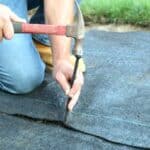
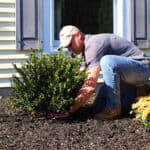
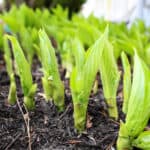
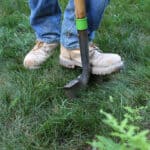
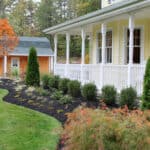

Is it possible to buy large amounts of good quality mulch Where to get it Can you recommend some small shrubs for small areas Thanks
Hy Phyllis… You’ll want to check out local garden centers and ask them for their bulk prices and ask if they deliver. Mulch is very regional so there’s not really one specific place I can recommend.